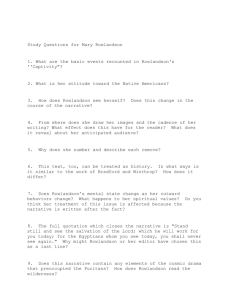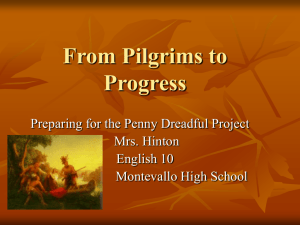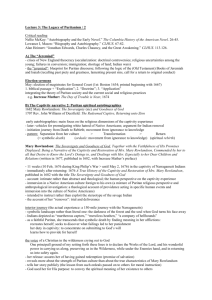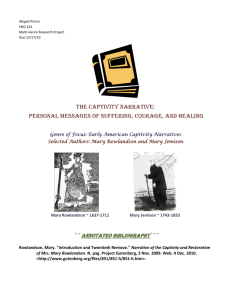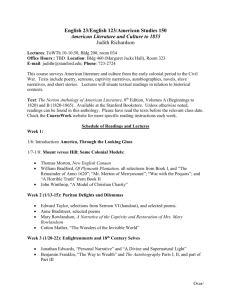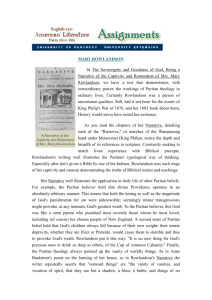Early American Captivity Narratives
advertisement
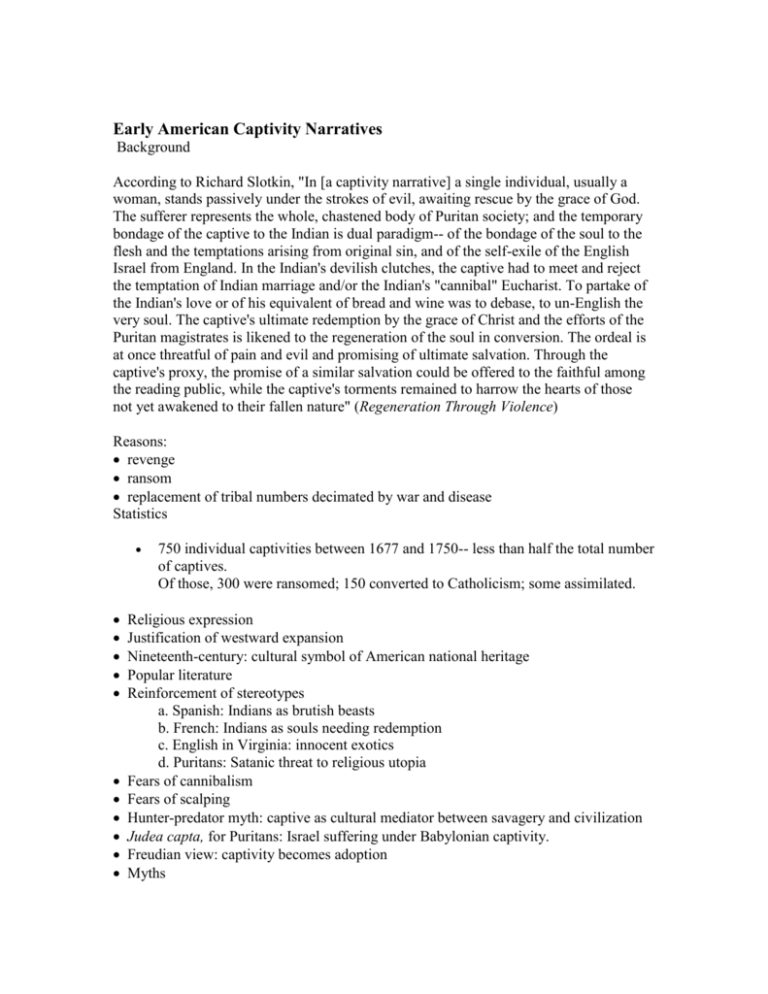
Early American Captivity Narratives Background According to Richard Slotkin, "In [a captivity narrative] a single individual, usually a woman, stands passively under the strokes of evil, awaiting rescue by the grace of God. The sufferer represents the whole, chastened body of Puritan society; and the temporary bondage of the captive to the Indian is dual paradigm-- of the bondage of the soul to the flesh and the temptations arising from original sin, and of the self-exile of the English Israel from England. In the Indian's devilish clutches, the captive had to meet and reject the temptation of Indian marriage and/or the Indian's "cannibal" Eucharist. To partake of the Indian's love or of his equivalent of bread and wine was to debase, to un-English the very soul. The captive's ultimate redemption by the grace of Christ and the efforts of the Puritan magistrates is likened to the regeneration of the soul in conversion. The ordeal is at once threatful of pain and evil and promising of ultimate salvation. Through the captive's proxy, the promise of a similar salvation could be offered to the faithful among the reading public, while the captive's torments remained to harrow the hearts of those not yet awakened to their fallen nature" (Regeneration Through Violence) Reasons: revenge ransom replacement of tribal numbers decimated by war and disease Statistics 750 individual captivities between 1677 and 1750-- less than half the total number of captives. Of those, 300 were ransomed; 150 converted to Catholicism; some assimilated. Religious expression Justification of westward expansion Nineteenth-century: cultural symbol of American national heritage Popular literature Reinforcement of stereotypes a. Spanish: Indians as brutish beasts b. French: Indians as souls needing redemption c. English in Virginia: innocent exotics d. Puritans: Satanic threat to religious utopia Fears of cannibalism Fears of scalping Hunter-predator myth: captive as cultural mediator between savagery and civilization Judea capta, for Puritans: Israel suffering under Babylonian captivity. Freudian view: captivity becomes adoption Myths a. Myth of Love in the Woods (Pocahontas and John Smith) b. Myth of Good Companions in the Wilderness (Cooper's Natty Bumppo and Chingachgook) c. Myth of White Woman with a Tomahawk (Hannah Dustan; inverts Pocahontas; kills 10 Indians and scalps them when she escapes.) Abruptly brought from state of protected innocence into confrontation with evil. Forced existence in alien society. Unable to submit or resist. Yearns for freedom, yet fears perils of escape. Struggle between assimilation and maintaining a separate cultural identity. Condition of captive parallels suffering of all lowly and oppressed. Growth in moral and spiritual strength. Deliverance. Separation: attack and capture Torment, ordeals of physical and mental suffering Transformation (accommodation, adoption) Return (escape, release, or redemption) Mary Rowlandson was born circa 1637-1638 in England. With her parents John and Joan White, she sailed for Salem in 1639. Joseph Rowlandson became a minister in 1654 and two years later he and Mary were married. They had a child, Mary, who lived for three years; their other children were Joseph, b. 1661; Mary, b. 1665; Sarah, b. 1669. At the time of their capture, the children were 14, 10, and 6. In 1675 Joseph Rowlandson. went to Boston to beg for help from the Massachusetts General Assembly, during which period Mary Rowlandson was captured. After her redemption, the couple lived in Boston and then moved 1677 to Wethersfield, Connecticut. Joseph Rowlandson died 24 November 1678 after preaching a powerful fast-day jeremiad. Mary Rowlandson remarried 6 Aug 1679 to Captain Samuel Talcott. He died in 1691; she lived until 1710. Disgrace later came to the family: her son Joseph got his brother-in-law drunk and sold him into servitude in Virginia. While a prisoner, Mary Rowlandson travelled some 150 miles, from Lancaster to Menamaset then north to Northfield and across the Connecticut river to meet with King Philip/Metacomet himself, sachem of the Wampanoags. Next she traveled up into southwestern New Hampshire, south to Menamaset, and north to Mount Wachusett.

